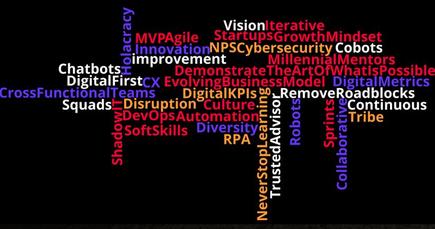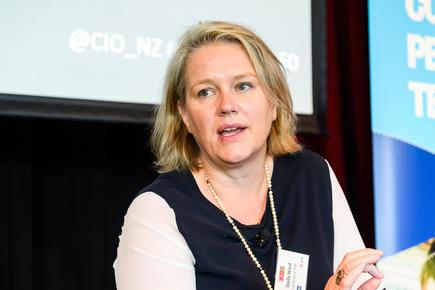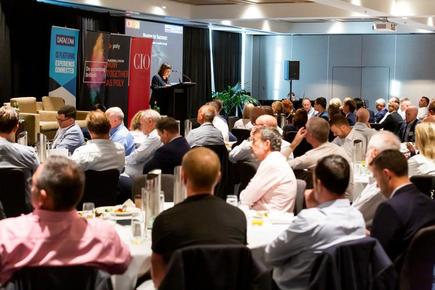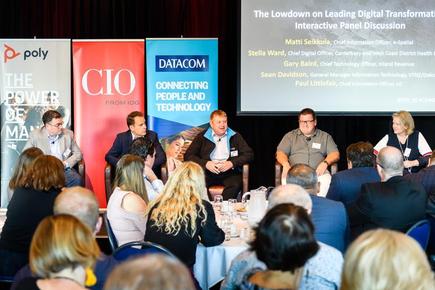
“The role of CIO is potentially a fearful one,” says Rebecca Thomas, CIO at PwC in New Zealand.
This, she says, could stem from being responsible for so many pieces of hardware and software, and the business impact their failure could bring.
“Fear brings out the worst in people. The default response is to try to control everything,” she shares. “I have learnt that this response doesn’t get the best results.”
“I cannot count the times that I have been faced with a problem and by getting a range of people in the room to look at the problem, including those outside of IT, what has emerged is a truly amazing solution.”

Thomas encapsules the new leadership framework that the CIO50 executives are taking as they lead programmes that take their organisations into the fast-paced digital era.
Collaboration, co-creation, co-design are just some of the terms we are hearing from the CIO50 leaders we have interviewed for this report.

The leaders were chosen by a panel of judges based on their programmes on business innovation and leadership.
Nominate your work for the 2020 CIO50
This is a very strategic group - 86 per cent are members of the executive leadership team, with a similar percentage reporting directly to the CEO or equivalent in the organisation.
Meet the 2019 CIO50 leaders and the ‘ones to watch’
There are 12 women in the group, and five of them are in the top 25 ranking.
There are 11 leaders in this group, who manage teams based overseas - across the globe, within the Asia Pacific region, or ANZ.

There are 11 chief digital officers in the group.
Six of them started as CIOs and were later asked to step up to the inaugural chief digital officer role in the same organisation.

They come from different industries and sectors, and represent organisations of different sizes across New Zealand.
There are, nonetheless, common themes that have emerged on their approach to lead through a rapidly changing environment.
Set the foundation to enable change
The CIO50 leaders show how moving into a multi-cloud environment and establishing quality data platforms and models are critical to any organisation, if they want to take advantage of digital technologies now and in the future to move at a speed the organisation demands.
This, however, goes beyond bolting in technologies. As one CIO50 leader puts it, to be successful, they had to transform the entire organisation.
This requires top level support and working with executive peers and other business unit heads.
Preparing the team for this massive change is key.
One CIO created an in-house programme for the development team. For 10 weeks, the software team went tools down to complete extensive training in cloud-based technologies.
“We wanted to take ownership of our future and set our people up for success and become really cloud native,” says this CIO, on the unprecedented move to invest the resources and time for the training.
Concurrent and equally strong focus on culture
Any discussion on technology-enabled change must encompass the people who are impacted: the customers, partners, and internal staff.
It is an entire ecosystem.
Plus, as the CIO50 leaders repeatedly stress, this side of change - culture - is just as important in any transformation programme and should be factored from the start.
In one organisation, there has to be a change readiness assessment, which the CIO ensures before starting every project.
Don’t follow a rulebook and instead, do what’s right for your organisation and culture
Getting staff members to use new digital tools implies changing existing ways of doing things, and so it is very important for the benefits to be clearly articulated and the restrictions or shortcomings identified, says this CIO.
Another states: “Help your people understand what they are expected to do differently. The leaders, who manage those people, are your best change ambassadors: make sure they have the tools, skills, and information they need to help their people.”
Taking along all the people for the change ahead is the true measure of an inclusive leader.
The CIO leaders proudly note how they are continuously working on building a more diverse team. These range from comprehensive programmes like ensuring that they have a diverse set of candidates to choose from when recruiting for a role.
They take long-term steps like a graduate programme to introduce staff from different backgrounds, or it could be a simple ‘plus one policy’. This means a senior member of the team who is invited to an external event as a speaker or to receive a citation will take along a female staff member or a new team member.
Trusted advisors
The CIO has to educate and communicate to the wider business where technology can be used as an enabler to meet the strategic needs of the business. To become this “trusted advisor”, however, requires understanding the industry and the ability to build relationships at all levels of the organisation.
Another CIO says gaining this trust starts with ensuring ICT has comprehensive, robust strategies that support the strategic priorities of the business. This gives confidence to the wider organisation that ICT has a solid approach to partnering with it.
One CIO organised the ICT team to “demonstrate the art of what is possible” by developing master classes on key technologies and new areas they are working in. These are then recorded and made available across the organisation.
In line with this, CIO50 leaders are now holding regular technology expos, where they demonstrate the projects they are working on and letting people outside ICT get to know the technologies that are being deployed across the organisation.
Another CIO proffers building initiatives that directly align with the KPIs of other functions. For instance, one CIO worked with the HR team in using gamification principles to help upskill staff.
Build alliances
Success comes from working together, says one CIO 50 leader.
Thus, this year, CIO50 leaders talk about co-creating, co-designing, co-locating, and building and working in cross-functional teams.
More CIOs talk about ensuring their team members take on secondment roles outside ICT, and for staff in other business units to work with them on a range of projects.
One strongly encourages the team members to take on secondments with customer facing roles across the organisation.
Another encourages team members to talk to people in operations. They know better than anyone else what is going on and what needs to change. They can present excellent opportunities for innovation and training, says this CIO.
The CIO50 leaders find one of their greatest allies in the executive team for such are their counterparts in people and performance (HR). This is important to ensure they cater to current needs, but also develop the competencies needed for the future workforce.
Most importantly, CIOs know that the best allies they can have for success are the staff themselves. Thus, they cite how any changes they implement should also commence with better user experience, not only for their customers but to the internal teams.
No rulebook for digital transformation
Know what works for your organisation, not follow a ‘paint by numbers recipe’, says one CIO50 leader.
Organisational context and culture are the most important considerations for the approach to take as the business adopts digital technologies and changes the way it operates.
As one CIO leader points out, frameworks and structure are helpful to get started, but sooner rather than later, they have to start trusting what is right for the organisation and to get the work done.
“Don’t follow a rulebook and instead, do what’s right for your organisation and culture.”
Resiliency
The CIO50 responsibilities go beyond the confines of their organisation. They work with community groups, industry networks. Their CIO colleagues ask them to talk to their teams and share lessons learned.
They mentor, advise university programmes and polytechs on courses that are needed for current and future workplaces. They and their teams also go to schools and career fairs to help encourage people to consider a career in ICT.
The CIO is always continuously learning, constantly checking out what is new, talking to colleagues in adjacent industries. All these activities inform their strategy on the frameworks to use in bringing about change.
Now that the organisation is aware of the capabilities of what a CIO and the team to deliver iterative projects and continuous improvement, they will expect the same, if faster, cadence in the months ahead.
One CIO says “pace yourself” and “you don’t need to own everything” are key phrases that apply as technology and digital leaders work through a raft of programmes.
Being resilient in this manner is one key trait demanded of today’s business technology and digital leaders.
This admonition also applies to the team and the rest of the organisation.
A CIO50 leader said they have started weekly ‘peak and pit’ to encourage the team to support each other in alleviating stress that comes with a fast paced, high-growth environment.
Expect this issue to be more prominent in the months ahead, and, be part of any business/digital transformation programme.

This is an excerpt from the overview of the 2019 CIO50 presented by the author during the CIO50 events in Auckland and Wellington

Get the latest on digital transformation: Sign up for CIO newsletters for regular updates on CIO news, career tips, views and events. Follow CIO New Zealand on Twitter:@cio_nz
Send news tips and comments to divina_paredes@idg.co.nz @divinap
Join the CIO New Zealand group on LinkedIn. The group is open to CIOs, IT Directors, COOs, CTOs and senior IT managers.
